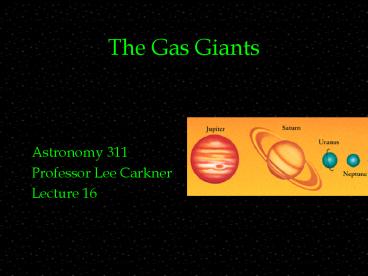The Gas Giants - PowerPoint PPT Presentation
1 / 28
Title:
The Gas Giants
Description:
Uranus. Diameter: 4.01. Mass: 14.50. Orbital Radius: 19.19. Neptune. Diameter: ... Uranus and Neptune ... Uranus: Neptune: For comparison Earth's density ... – PowerPoint PPT presentation
Number of Views:335
Avg rating:3.0/5.0
Title: The Gas Giants
1
The Gas Giants
- Astronomy 311
- Professor Lee Carkner
- Lecture 16
2
Gas Giant Basics
- The 4 largest planets of the solar system are the
gas giants
3
Missions to the Outer Planets
- 1972 Pioneer 10 --
- 1973 Pioneer 11 --
- 1977 Voyager 1 --
- 1977 Voyager 2 --
- 1989 Galileo --
- 1997 Cassini --
4
Voyager 2
- Launched August 20 1977
- Used gravity of each planet to change orbit to
get to the next - Is still taking data on the edge of the solar
system
5
Voyager 2s Grand Tour
6
Gas Giant Facts
- Jupiter
- Diameter 11.21
- Mass 317.83
- Orbital Radius 5.20
- Saturn
- Diameter 9.42
- Mass 95.16
- Orbital Radius 9.54
- Uranus
- Diameter 4.01
- Mass 14.50
- Orbital Radius 19.19
- Neptune
- Diameter 3.88
- Mass 17.20
- Orbital Radius 30.06
- Numbers are relative to the Earth
7
Orbits
- Orbital radii for the outer planets range from
5-30 AU
8
Sizes of the Gas Giants
- Gas giants are all very large compared to the
terrestrial planets - Jupiter and Saturn about 10 Earth diameters
- Uranus and Neptune about 4 Earth diameters
- The gas giants contain 99 of the mass of the
solar system (not including the Sun)
9
Densities
- The gas giants have very low densities
- Average density (kg/m3)
- Jupiter
- Saturn
- Uranus
- Neptune
- For comparison Earths density is 5515
10
Composition
- The gas giants have a low density because they
are made up mostly of hydrogen and helium the 2
lightest elements - Total composition
11
Surface and Atmosphere
- The gas giants do not have a real surface
12
Atmospheric Features
- Clouds
- Bands
- Storms
13
Jupiters Great Red Spot
14
Neptunes Great Dark Spot
15
Hurricane on Earth
16
Saturns Atmosphere
17
Traveling Through the Solar System
18
Structure
- The gas giants are not perfectly round, they are
oblate due to rotation - Degree of oblateness depends on mass distribution
- Gas giants also have a magnetic field
19
Internal Structure of Jupiter
20
Moons
- Number of satellites (larger than 10 km)
- Range in size from Ganymede (larger then Mercury)
to small pieces of rock
21
Moon Properties
- Satellites tend to be composed of rock and ice
- Many have rocky cores and icy surfaces
- The satellites are very diverse
22
Jupiters Satellites
23
Saturns Satellites
24
Rings
- All of the gas giants have rings of small
particles - Rings consist of material that has fallen inside
the Roche limit
25
Saturns A Ring
26
Differences Between the Gas Giants
- Jupiter and Saturn are larger ,warmer and have
more distinct cloud features
27
Summary
- Size 4-11 times Earth diameter
- Mass 15-318 Earth masses
- Composition mostly hydrogen and helium
- Atmosphere clouds of methane and ammonia
- also have large, long-lived storm systems and
oppositely moving bands
28
Summary The Jovian Systems
- The gas giants have extensive satellite systems
- Many moons have icy exteriors with rocky cores
- Some are very large (size of Earths Moon)
- All of the outer planets (not just Saturn have
ring systems) - rings composed of small particles
- Ring properties different for each planet































